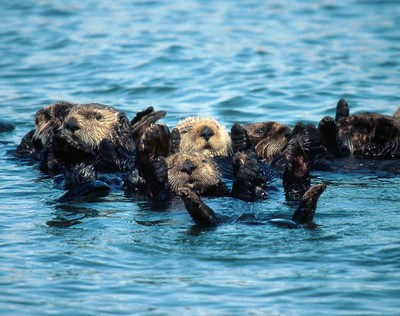
Credit: USFWS Photo Identification: Sea otters can be seen from boat or land as they float in the Pacific Ocean. Having been reintroduced to their native park waters, sighting one of these creatures can be quite exciting! While river otters can also occasionally be seen fishing and swimming in the ocean water, sea otters differ from them in their looks. Sea otters are much larger, weighing about 50 – 100 pounds (23 – 45 kg). They will typically have a dark brown body with a white face, which you will see sticking out of the water as they float on their backs. Habitat: Sea otters are fully aquatic, meaning they do not live on land, although they can get up on the land. Rather, they live in the Pacific Ocean, especially near shore lines. They can be found foraging and resting within the large kelp beds. Diet: Sea otters will dive into kelp forests and to the sea floor searching for a variety of snacks. They eat crabs, clams, mussels, urchins, snails and the northern sea otter subspecies that live in Olympic’s water will even eat fish. Role in the Ecosystem: Sea otters were reintroduced into the ocean waters along the Peninsula due to their importance! Sea otters are a “keystone species,” meaning that they are an indicator to the health of a habitat. If their population is healthy, it means that other parts of the ecosystem are likely also healthy. In your own home, if you are healthy, that likely means that there is enough food nearby, your air quality is good for you to breathe, and there is enough water for you to survive. Not all places on Earth are suitable for people to survive and not all seas are suitable for otters to survive. They help to tell the story of the health of the seas. Fun Fact: Sea otters form “rafts” of 10-100 individuals by using kelp to tie themselves to other sea otters of the same sex while they rest and eat. There are three subspecies of Sea Otter, depending upon where they live (the Southern or California sea otter, the Northern sea otter, and the Russian sea otter). Back to Species List |
Last updated: September 21, 2020
